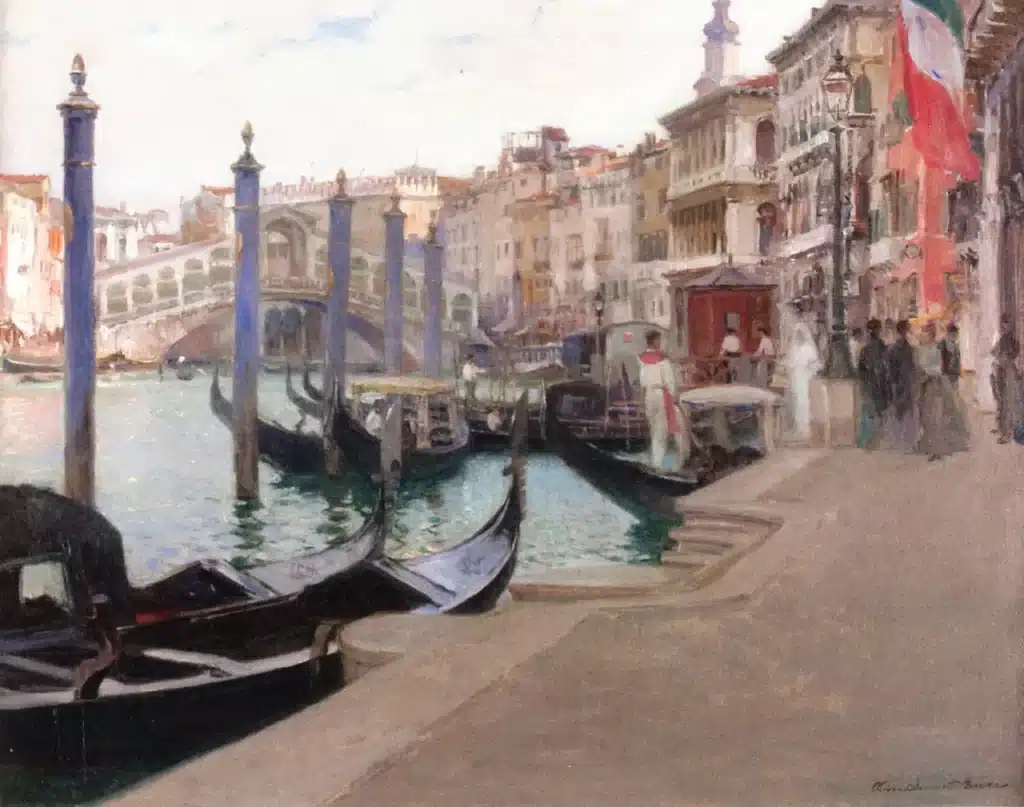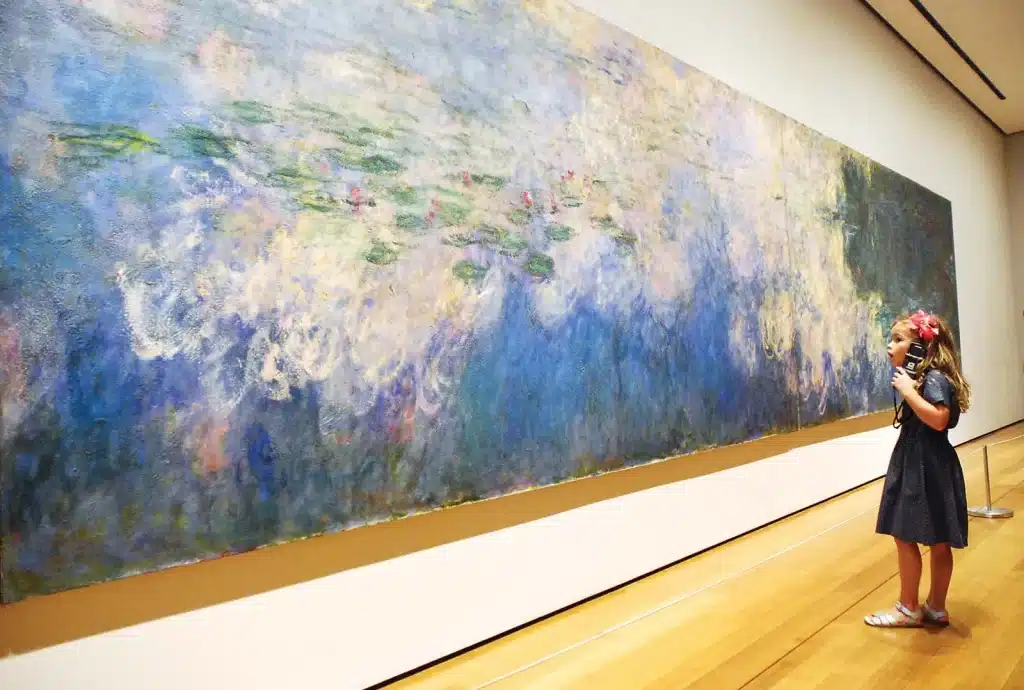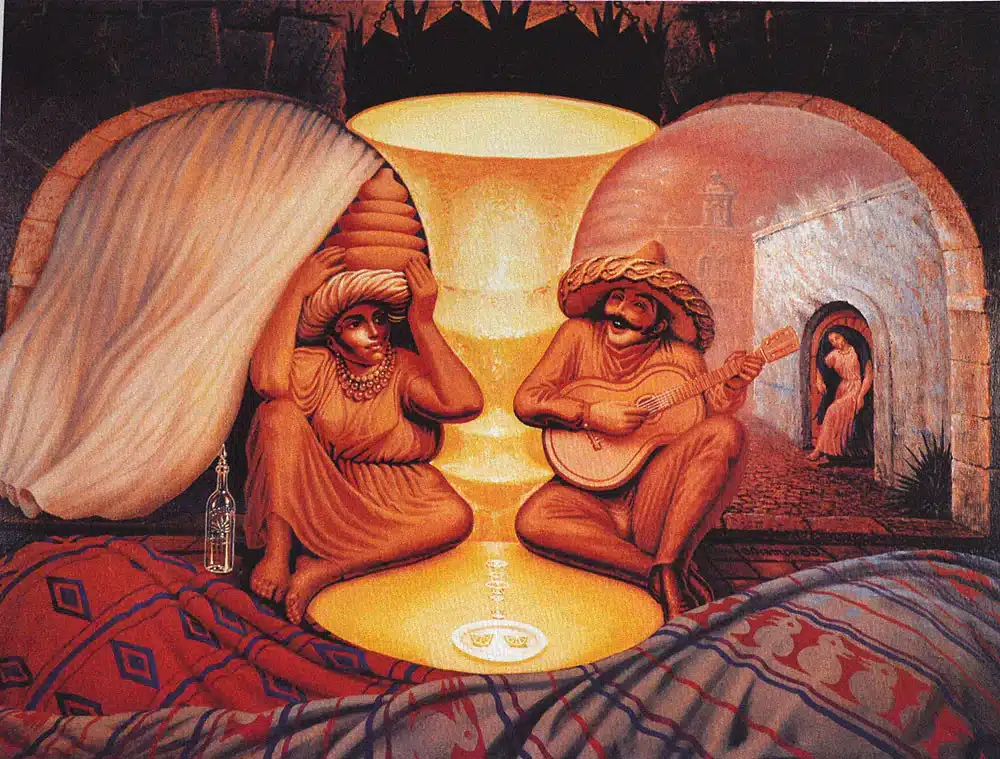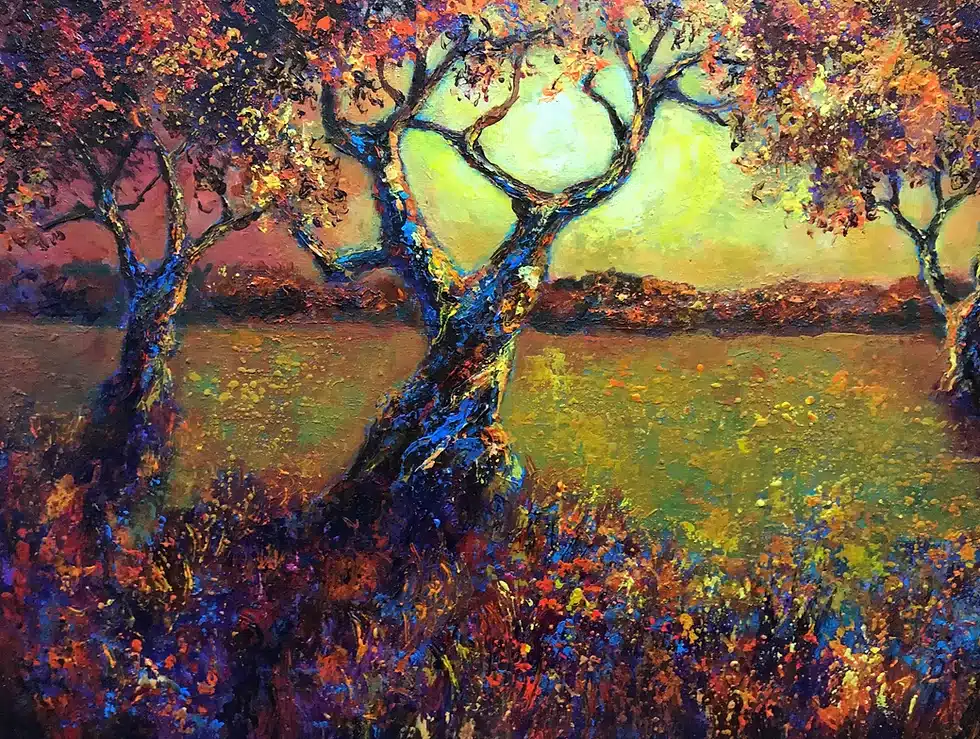Grasping the essence of an artist’s vision can be challenging, especially when exploring a diverse group united only by the first letter of their name.
Yet, artists whose names begin with ‘O’ have made remarkable contributions to the art world, offering a rich tapestry of styles and perspectives.
These artists have profoundly shaped art history, from Odilon Redon’s mystical symbolism to Otto Mueller’s bold expressionism.
Their works provide unique insights into cultures, historical periods, and artistic movements.
This article will explore six notable ‘O’ artists and their famous paintings.
You’ll discover how each artist’s unique style and vision contributed to the broader narrative of art history.
By the end, you’ll have a deeper appreciation for the diverse artistic expressions that flourish under the letter ‘O’.
Famous Paintings and Artists Whose Names Start with O
1. Odilon Redon

Artist Background
- Odilon Redon, a French symbolist painter, was born in 1840.
- He drew inspiration from literature and his imagination.
- His work often features dreamlike mythological subjects.
Painting Analysis
- “Buddah in His Youth” shows Redon’s signature style.
- The painting uses soft colors and ethereal forms to depict the young Buddha.
- It invites viewers to contemplate spirituality and youthful wisdom.
Artistic Impact
- This work exemplifies Redon’s ability to blend the spiritual and the surreal.
- It influenced later symbolist and surrealist movements.
- The painting continues to fascinate viewers with its mystical quality.
Redon’s “Buddah in His Youth” is a testament to the power of imagination in art.
It bridges the gap between the visible and invisible worlds, inviting us to look beyond the surface and explore deeper meanings.
2. Oscar Begas

Artist Background
- Oscar Begas, a German painter, was active in the 19th century.
- He came from a family of artists and was known for his portraits.
- Begas studied at the Berlin Academy of Arts.
Painting Analysis
- “Portrait of the Artist’s Daughter” shows Begas’s skill in capturing emotion.
- The painting uses warm tones and soft lighting to create an intimate atmosphere.
- It reveals the close bond between the artist and his subject.
Artistic Impact
- Begas’s work contributed to the tradition of familial portraiture.
- His paintings offer insights into 19th-century German society and family life.
- This portrait stands out for its personal and emotional depth.
The “Portrait of the Artist’s Daughter” reflects the tenderness of a father’s gaze.
It captures a moment of quiet contemplation between artist and subject, reminding us of the power of art to preserve personal relationships.
3. Otto Mueller

Artist Background
- Otto Mueller, born in 1874, was a German painter and printmaker.
- He was a key member of the expressionist group ‘Die Brücke.’
- Mueller often depicted nature and marginalized communities in his work.
Painting Analysis
- “Gypsy with Two Children” shows Mueller’s distinctive style.
- The painting uses simplified forms and earthy colors to portray its subjects.
- It captures the essence of nomadic life and human connection.
Artistic Impact
- Mueller’s work brought attention to often-overlooked communities.
- His style influenced the development of German Expressionism.
- This painting challenges societal norms and celebrates human diversity.
“Gypsy with Two Children” is a powerful statement on humanity and belonging.
It invites viewers to reconsider their perceptions of marginalized groups.
The work continues to resonate with its message of empathy and understanding.
4. Oliver Rhys
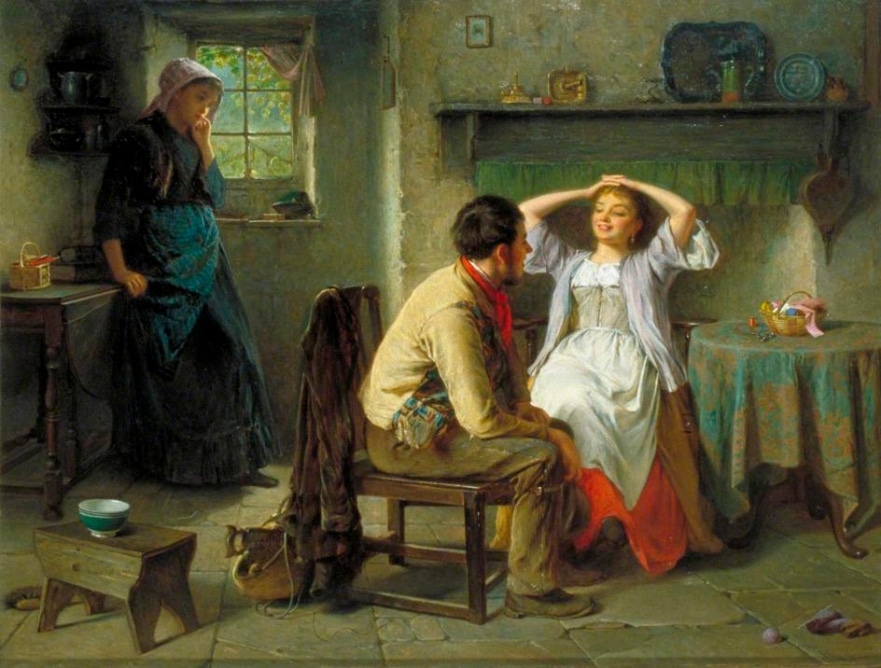
Artist Background
- Oliver Rhys was a British painter active in the late 19th century.
- He specialized in genre scenes and narrative paintings.
- Rhys was known for his ability to capture human emotions and interactions.
Painting Analysis
- “Jealousy and Flirtation” showcases Rhys’s talent for storytelling through art.
- The painting depicts a complex social scene with subtle emotional undertones.
- It uses body language and facial expressions to convey the story.
Artistic Impact
- Rhys’s work provides a window into Victorian social dynamics.
- His paintings often explore themes of romance, jealousy, and social etiquette.
- This piece continues to engage viewers with its relatable human drama.
“Jealousy and Flirtation” invites us to observe a frozen moment. I
t sparks our imagination, encouraging us to fill in the backstory.
The painting reminds us of the timeless nature of human emotions and relationships.
5. Olof Johan Sodermark

Artist Background
- Olof Johan Sodermark was a Swedish painter of the 19th century.
- He was known for his realistic portraits and historical scenes.
- Sodermark studied art in Stockholm and Paris.
Painting Analysis
- “Karolina Bygler” shows Sodermark’s skill in capturing likeness and personality.
- The portrait uses a muted color palette to focus on the subject’s features.
- It conveys a sense of the sitter’s character and social status.
Artistic Impact
- Sodermark’s work contributed to the development of Swedish portraiture.
- His paintings provide valuable insights into 19th-century Swedish society.
- This portrait stands as a testament to his ability to capture individual essence.
“Karolina Bygler” invites us to look beyond the surface and into the subject’s inner world.
It serves as a bridge between past and present, connecting us with a historical figure.
The painting reminds us of the power of portraiture to preserve human stories.
6. Oliver Dennett Grover
Artist Background
- Oliver Dennett Grover was an American painter active in the late 19th and early 20th centuries.
- He was known for his landscapes and scenes of European cities.
- Grover studied in Paris and traveled extensively throughout Europe.
Painting Analysis
- “Wedding Day, Rialto Bridge, Venice” captures the romance of Venice.
- The painting uses light and color to create a festive atmosphere.
- It combines architectural detail with human activity to bring the scene to life.
Artistic Impact
- Grover’s work contributed to the American fascination with European scenes.
- His paintings offer a glimpse into the cultural exchange between America and Europe.
- This piece continues to evoke the timeless allure of Venice.
“Wedding Day, Rialto Bridge, Venice” transports viewers to a moment of joy and celebration.
It captures the essence of Venice as a city of love and beauty.
The painting reminds us of the power of art to preserve memories and emotions.
7. Otto Dix
Artist Background
- Otto Dix was a German painter and printmaker born in 1891.
- He was associated with the New Objectivity movement.
- Dix’s work often provided harsh critiques of German society.
Painting Analysis
- “Portrait of the Journalist Sylvia von Harden” showcases Dix’s sharp observational skills.
- The painting uses exaggerated features to convey the subject’s character.
- It captures the spirit of 1920s Berlin with its bold, unflinching style.
Artistic Impact
- Dix’s work influenced the development of social realism in art.
- His portraits offer a unique perspective on Weimar-era Germany.
- This painting continues to be recognized as an icon of 20th-century portraiture.
“Portrait of the Journalist Sylvia von Harden” challenges viewers with its stark realism.
It offers a window into the social and cultural climate of interwar Germany.
The work exemplifies Dix’s ability to capture the essence of an era through individual portraits.
8. Oscar-Claude Monet
Artist Background
- Oscar-Claude Monet was a French painter born in 1840.
- He was a founder of French Impressionist painting.
- Monet’s work focused on capturing the changing effects of light.
Painting Analysis
- The “Water Lilies” series represents Monet’s later work.
- These paintings depict the artist’s garden at Giverny.
- They showcase Monet’s mastery of color and light.
Artistic Impact
- The “Water Lilies” series influenced the development of abstract art.
- These works revolutionized the way artists approached landscape painting.
- They continue to inspire artists and captivate viewers worldwide.
Monet’s “Water Lilies” invites viewers to immerse themselves in a world of color and reflection.
They blur the line between representation and abstraction, representing Monet’s enduring vision and artistic innovation.
9. Okumura Masanobu
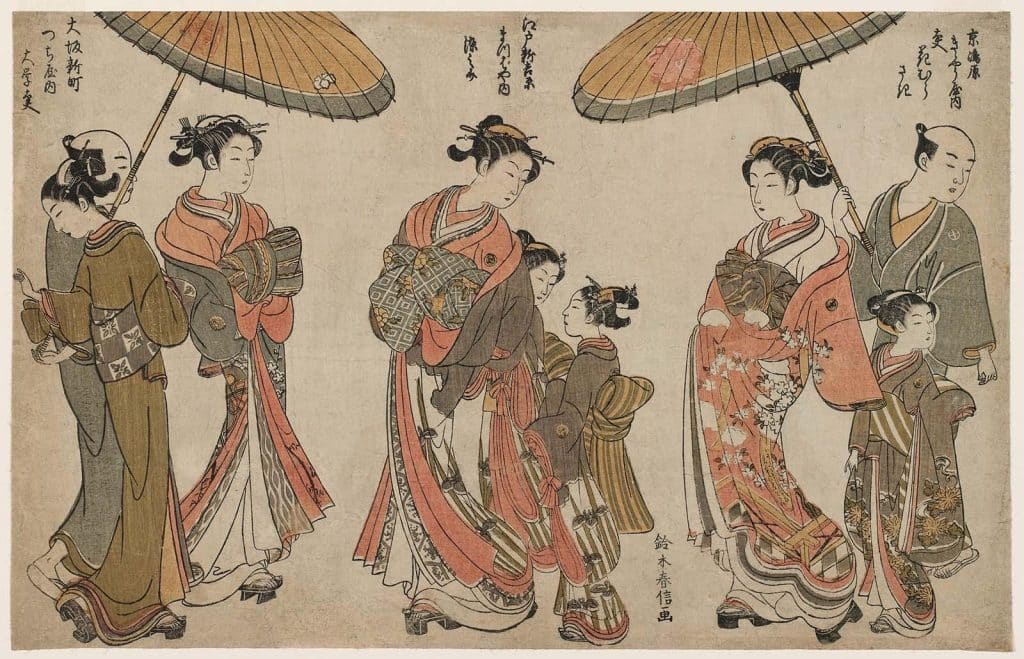
Artist Background
- Okumura Masanobu was a Japanese artist active in the early 18th century.
- He was a leading figure in the development of ukiyo-e art.
- Masanobu was known for his innovative printing techniques.
Painting Analysis
- “The Courtesan Hanamurasaki” exemplifies Masanobu’s style.
- The work uses bold lines and vibrant colors to depict its subject.
- It captures the elegance and sophistication of Edo-period courtesans.
Artistic Impact
- Masanobu’s work influenced the evolution of Japanese printmaking.
- His prints provide valuable insights into Edo-period culture and fashion.
- This piece continues to be studied for its artistic and historical significance.
“The Courtesan Hanamurasaki” offers a glimpse into the world of Edo-period Japan.
It showcases the beauty and complexity of ukiyo-e art and is a testament to Masanobu’s skill in capturing the essence of his time.
10. Olga Boznanska
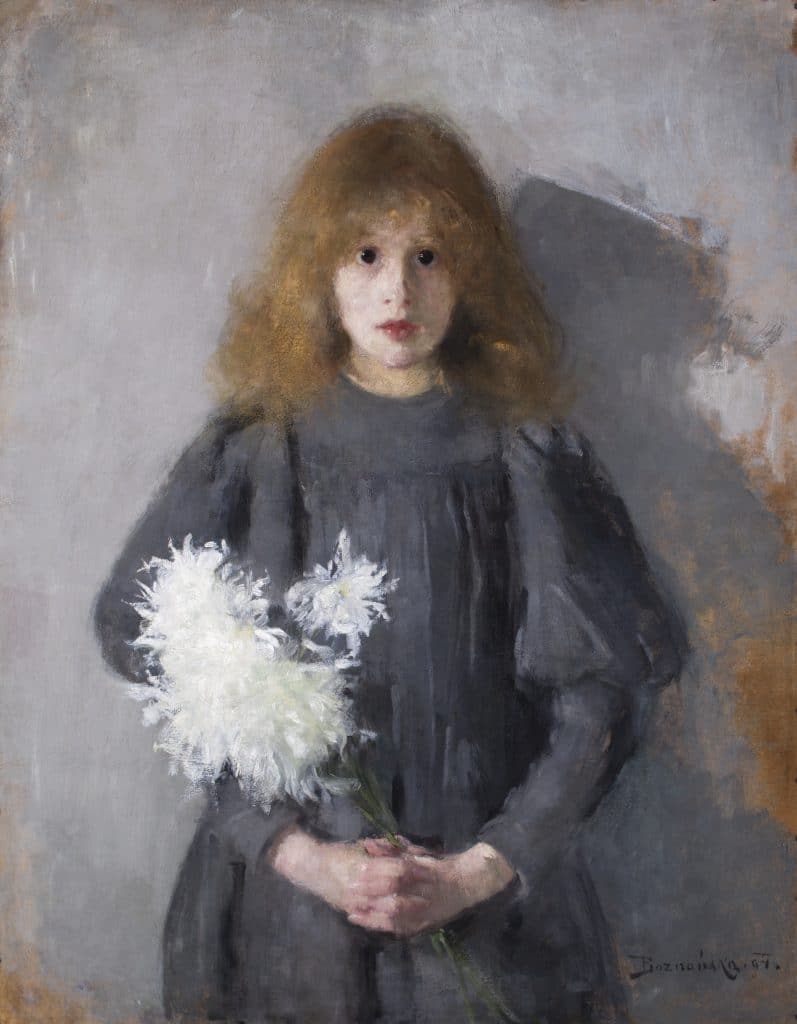
Artist Background
- Olga Boznanska was a Polish painter active in the late 19th and early 20th centuries.
- She was known for her portraits and still-life paintings.
- Boznanska studied in Munich and later worked in Paris.
Painting Analysis
- “Girl with Chrysanthemums” showcases Boznanska’s unique style.
- The painting uses soft, muted colors to create a dreamy atmosphere.
- It captures the reflective mood of the young subject.
Artistic Impact
- Boznanska’s work influenced the development of Polish modernism.
- Her portraits are noted for their psychological depth.
- This painting continues to be celebrated for its subtle emotional power.
“Girl with Chrysanthemums” invites viewers to contemplate the inner world of its subject.
It demonstrates Boznanska’s ability to capture mood and personality through color and form.
The work is a testament to the artist’s unique vision and technical skill.
11. Orazio Gentileschi

Artist Background
- Orazio Gentileschi was an Italian Baroque painter born in 1563.
- He was a follower of Caravaggio and the father of Artemisia Gentileschi.
- Gentileschi worked in Italy, France, and England during his career.
Painting Analysis
- “Judith and Her Maidservant” depicts a scene from the Biblical story of Judith.
- The painting uses dramatic lighting to create a sense of tension and mystery.
- It showcases Gentileschi’s skill in rendering textures and emotions.
Artistic Impact
- Gentileschi’s work influenced the development of Baroque painting.
- His treatment of biblical subjects added new depth to religious art.
- This painting continues to be studied for its technical mastery and storytelling.
“Judith and Her Maidservant” draws viewers into a moment of high drama.
It exemplifies the power of Baroque art to evoke emotion and tell stories.
The work is a testament to Gentileschi’s ability to bring ancient tales to life.
12. Owen Jones
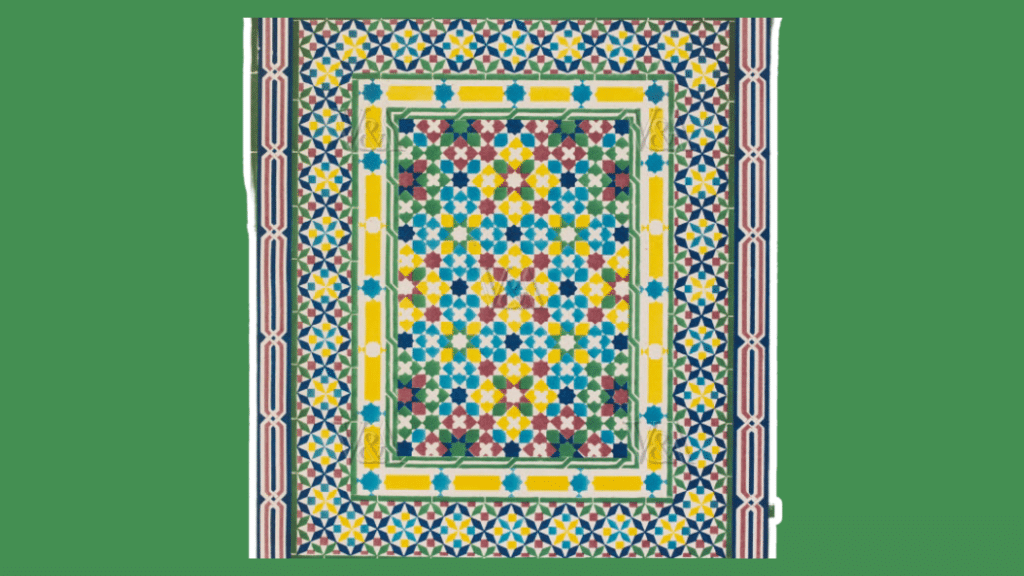
Artist Background
- Owen Jones was a British architect and designer born in 1809.
- He was a key figure in developing decorative arts in Victorian England.
- Jones was known for his studies of color theory and ornament.
Painting Analysis
- “Design for Mosaic and Tesselated Pavements” showcases Jones’s innovative approach to pattern.
- The work uses geometric forms and vibrant colors to create intricate designs.
- It demonstrates Jones’s interest in Islamic art and architecture.
Artistic Impact
- Jones’s work influenced the development of industrial design and interior decoration.
- His theories on color and form had a lasting impact on Victorian aesthetics.
- This design continues to inspire contemporary artists and designers.
Jones’s “Design for Mosaic and Tesselated Pavements” challenges viewers with its complexity.
It invites us to appreciate the beauty of mathematical precision in art and stands as a testament to Jones’s vision of a unified theory of ornament.
13. Osias Beert
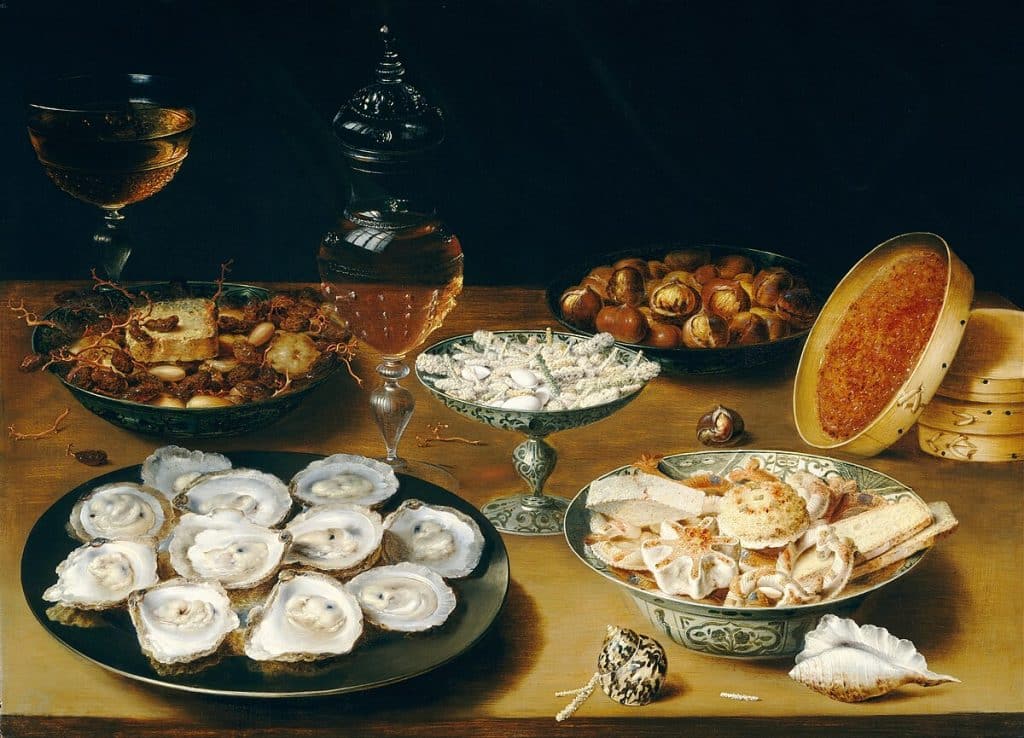
Artist Background
- Osias Beert was a Flemish painter active in the early 17th century.
- He was known for his still-life paintings, particularly of flowers and food.
- Beert was a member of the Antwerp Guild of Saint Luke.
Painting Analysis
- “Dishes with Oysters, Fruit, and Wine” exemplifies Beert’s style.
- The painting uses careful composition to highlight each element.
- It showcases Beert’s skill in rendering different textures and surfaces.
Artistic Impact
- Beert’s work contributed to the development of still-life painting in Northern Europe.
- His paintings offer insights into 17th-century Dutch and Flemish culture.
- This piece continues to be admired for its technical skill and aesthetic appeal.
“Dishes with Oysters, Fruit, and Wine” invites viewers to feast their eyes on a sumptuous display.
It reminds us of the rich tradition of still-life painting in European art.
The work stands as a testament to Beert’s mastery of his craft.
14. Oswaldo Guayasamín

Artist Background
- Oswaldo Guayasamín was an Ecuadorian painter and sculptor born in 1919.
- He was known for his powerful, politically charged artworks.
- Guayasamín’s work often addressed themes of human suffering and injustice.
Painting Analysis
- “The Age of Wrath” is part of a larger series exploring human emotion.
- The painting uses bold lines and distorted forms to convey intense feelings.
- It captures the artist’s response to social and political turmoil.
Artistic Impact
- Guayasamín’s work influenced the development of Latin American expressionism.
- His paintings brought global attention to social issues in Ecuador and beyond.
- This piece continues to resonate with viewers for its emotional intensity.
“The Age of Wrath” confronts viewers with raw human emotion.
It challenges them to consider the impact of social and political forces on individuals.
The work is a powerful testament to art’s ability to address urgent social issues.
15. Orest Kiprensky

Artist Background
- Orest Kiprensky was a Russian portraitist born in 1782.
- He was a leading figure in the development of Russian Romanticism.
- Kiprensky studied and worked in both Russia and Italy.
Painting Analysis
- “Portrait of Alexander Pushkin” depicts the famous Russian poet.
- The painting uses warm colors and soft lighting to create an intimate atmosphere.
- It captures Pushkin’s thoughtful expression and creative spirit.
Artistic Impact
- Kiprensky’s work influenced the development of portraiture in Russia.
- His paintings helped to establish a distinctly Russian school of painting.
- This portrait continues to be celebrated as an iconic image of Pushkin.
“Portrait of Alexander Pushkin” invites viewers to connect with one of Russia’s greatest poets.
It offers a window into the cultural world of early 19th-century Russia.
The work is a testament to Kiprensky’s skill in capturing the essence of his subjects.
16. Octavio Ocampo
Artist Background
- Octavio Ocampo is a Mexican surrealist artist born in 1943.
- He is known for his metamorphic style of painting.
- Ocampo’s work often incorporates multiple images within a single composition.
Painting Analysis
- “Forever Always” showcases Ocampo’s unique approach to visual illusion.
- The painting uses cleverly arranged elements to create multiple interpretations.
- It invites viewers to discover hidden images within the larger composition.
Artistic Impact
- Ocampo’s work has influenced the development of surrealist and optical illusion art.
- His paintings challenge viewers to engage actively with the artwork.
- This piece continues to fascinate audiences with its layered imagery.
“Forever Always” invites viewers to discover hidden meanings beyond the surface.
It demonstrates the power of art to challenge our perceptions and spark our imagination.
The work is a testament to Ocampo’s innovative approach to visual storytelling.
17. Ossip Zadkine
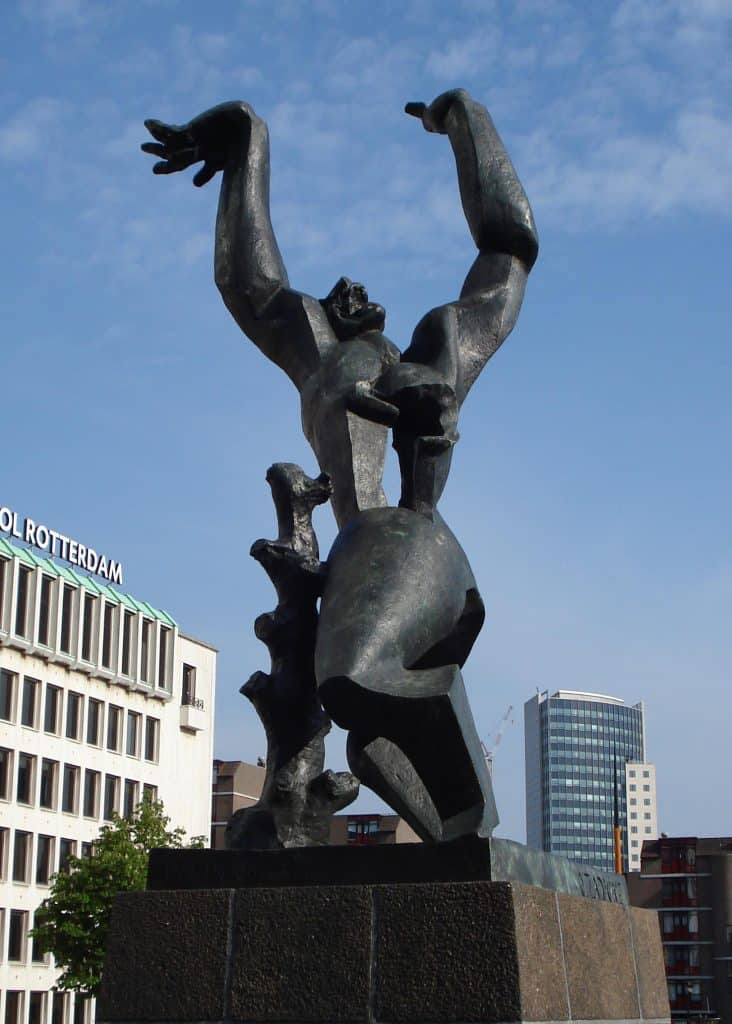
Artist Background
- Ossip Zadkine was a Russian-born French sculptor and painter born in 1890.
- He was associated with the Cubist movement.
- Zadkine’s work often dealt with themes of war and human suffering.
Painting Analysis
- “The Destroyed City” is a monumental sculpture created after World War II.
- The work uses distorted forms to convey the anguish of war-torn Rotterdam.
- It combines elements of abstraction and figuration to powerful effect.
Artistic Impact
- Zadkine’s work influenced the development of modern sculpture.
- His public art pieces brought modernist forms to a wider audience.
- This sculpture continues to serve as a poignant memorial to the victims of war.
“The Destroyed City” confronts viewers with the raw emotion of post-war Europe.
It is a powerful testament to art’s ability to commemorate and heal.
The work reminds us of the enduring impact of war on individuals and communities.
18. Orlando Norie
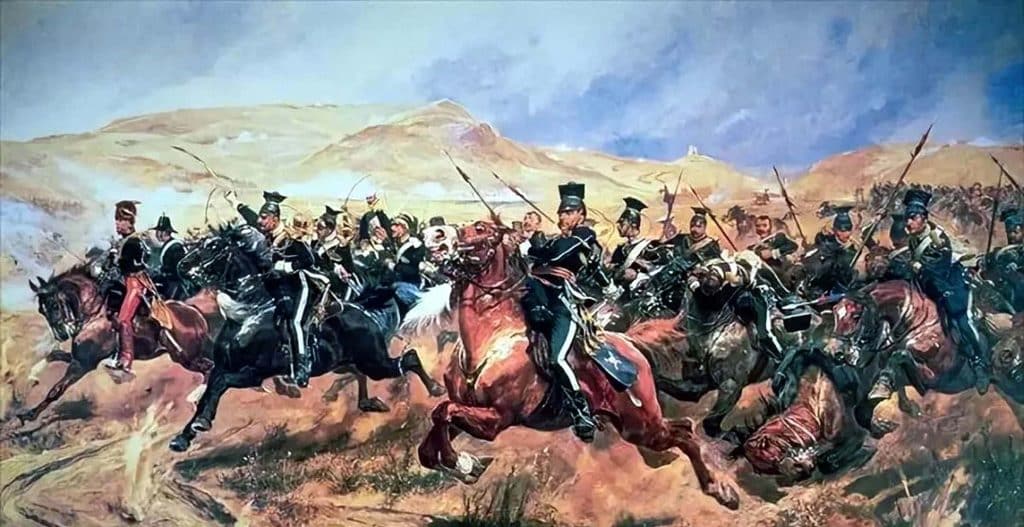
Artist Background
- Orlando Norie was a British painter active in the 19th century.
- He specialized in military scenes and was known for his attention to detail.
- Norie’s work provides a visual record of British military history.
Painting Analysis
- “The Charge of the Light Brigade” depicts a famous battle from the Crimean War.
- The painting uses dynamic composition to capture the chaos and heroism of the charge.
- It showcases Norie’s skill in rendering horses and soldiers in action.
Artistic Impact
- Norie’s work contributed to the tradition of military painting in Britain.
- His paintings offer valuable insights into 19th-century warfare and military life.
- This piece continues to be studied for its historical and artistic significance.
“The Charge of the Light Brigade” brings a moment of military history to life.
It invites viewers to reflect on the drama and tragedy of war.
The work is a testament to Norie’s skill in capturing the spirit of his time.
19. Oswald Achenbach

Artist Background
- Oswald Achenbach was a German landscape painter born in 1827.
- He was associated with the Düsseldorf school of painting.
- Achenbach was known for his romantic depictions of Italian landscapes.
Painting Analysis
- “View of the Bay of Naples” showcases Achenbach’s skill in capturing atmospheric effects.
- The painting uses warm colors and soft light to create a sense of Mediterranean beauty.
- It combines careful observation with the romantic idealization of the landscape.
Artistic Impact
- Achenbach’s work influenced the development of landscape painting in Germany.
- His paintings fueled the 19th-century fascination with Italian scenery.
- This piece continues to be admired for its evocative portrayal of southern Italy.
“View of the Bay of Naples” transports viewers to a sun-drenched Mediterranean scene.
It invites us to share the artist’s love for the Italian landscape.
The work is a testament to Achenbach’s ability to capture the essence of a place.
20. Octave Tassaert
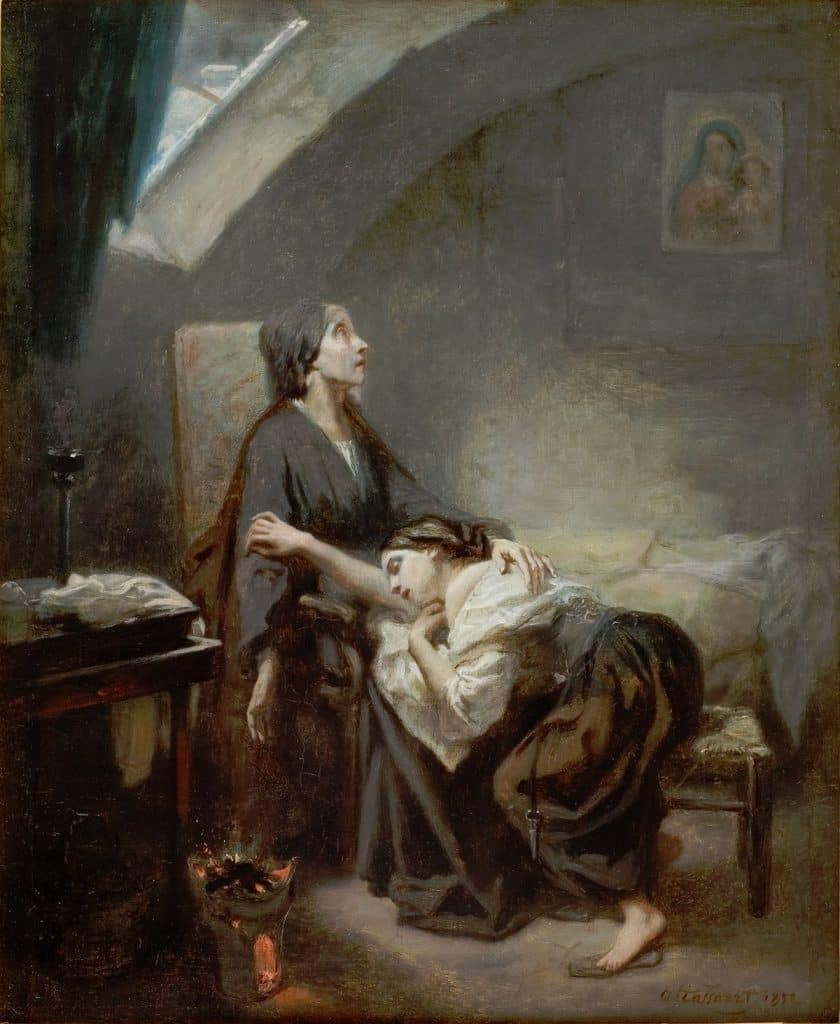
Artist Background
- Octave Tassaert was a French painter born in 1800.
- He was known for his genre scenes and religious paintings.
- Tassaert’s work often addressed themes of social injustice and human suffering.
Painting Analysis
- “Melancholy” depicts a young woman in a state of emotional distress.
- The painting uses subdued colors and dramatic lighting to convey mood.
- It captures a moment of private sorrow with sensitivity and empathy.
Artistic Impact
- Tassaert’s work influenced the development of social realism in French art.
- His paintings brought attention to the plight of the urban poor.
- This piece continues to resonate with viewers for its emotional depth.
“Melancholy” invites us to empathize with the subject’s inner turmoil.
It reminds us of art’s power to explore complex human emotions.
The work stands as a testament to Tassaert’s compassionate vision.
21. Olafur Eliasson
Artist Background
- Olafur Eliasson is a Danish-Icelandic artist born in 1967.
- He is known for his sculptures and large-scale installations.
- Eliasson’s work often explores the relationship between humans and their environment.
Painting Analysis
- “The Weather Project” was a large-scale installation at Tate Modern in London.
- The work used mirrors, mist, and artificial light to create an indoor “sun.”
- It invited viewers to interact with and reflect on their environment.
Artistic Impact
- Eliasson’s work has influenced the development of installation and environmental art.
- His projects challenge viewers to reconsider their relationship with nature and technology.
- This installation continues to be discussed for its innovative approach to public art.
“The Weather Project” transformed a museum space into a shared sensory experience.
It invited viewers to become active participants in the artwork.
The work is a testament to Eliasson’s ability to create immersive, thought-provoking environments.
22. Oliver Kemp

Artist Background
- Oliver Kemp was an American illustrator and painter active in the early 20th century.
- He was known for depicting outdoor life and adventure scenes, often appearing in popular magazines.
Painting Analysis
- “An Allegory of Youth” showcases Kemp’s romantic vision of youth and nature.
- The painting uses vibrant colors and dynamic composition to convey energy and optimism.
- It captures a moment of youthful exuberance in an idealized natural setting.
Artistic Impact
- Kemp’s work influenced the popular image of outdoor life in America.
- His illustrations helped to shape the visual culture of early 20th-century magazines.
- This piece continues to be appreciated for its celebration of youth and nature.
“An Allegory of Youth” invites viewers to share in a vision of youthful vitality.
It reminds us of the enduring appeal of nature and adventure in art.
It is a testament to Kemp’s skill in capturing the spirit of his time.
23. October Gold
Inspiration and Theme:
The painting draws inspiration from the rich colors of autumn.
- It explores themes of change, harvest, and the beauty of seasonal transitions.
- The work captures the essence of fall’s golden hues and fading light.
Color Palette and Technique
- The artist employs a warm color palette dominated by golds, oranges, and deep reds.
- Brushwork likely varies from broad strokes for foliage to finer details for texture.
- Light plays a crucial role, possibly depicting autumn’s soft, angled light.
Artistic Impact
- “October Gold” contributes to the tradition of seasonal landscape painting.
- It likely resonates with viewers’ autumn experiences and may influence how other artists depict fall scenes.
“October Gold” invites viewers to immerse themselves in the warmth of autumn.
It captures a fleeting moment of natural beauty, preserving it for contemplation.
The work celebrates nature’s cyclical changes and vibrant colors.
24. Ocean’s Embrace
Inspiration and Theme
- The power and majesty of the sea inspire the painting.
- It explores themes of nature’s force and movement and the human relationship with water.
- The work likely captures the dynamic energy of waves and tides.
Composition and Technique
- The composition probably emphasizes the vastness of the ocean.
- Brushwork techniques may vary to depict the different textures of water.
- The artist likely uses a range of blues and greens to capture the sea’s changing moods.
Artistic Impact
- “Ocean’s Embrace” contributes to the rich tradition of marine art. It may evoke strong emotional responses, from awe to trepidation.
- The painting could influence how other artists approach depicting water and waves.
“Ocean’s Embrace” draws viewers into the powerful world of the sea, reminding them of nature’s raw beauty and unstoppable force.
The work is a testament to artists’ enduring fascination with the ocean.
25. Orchard in Spring
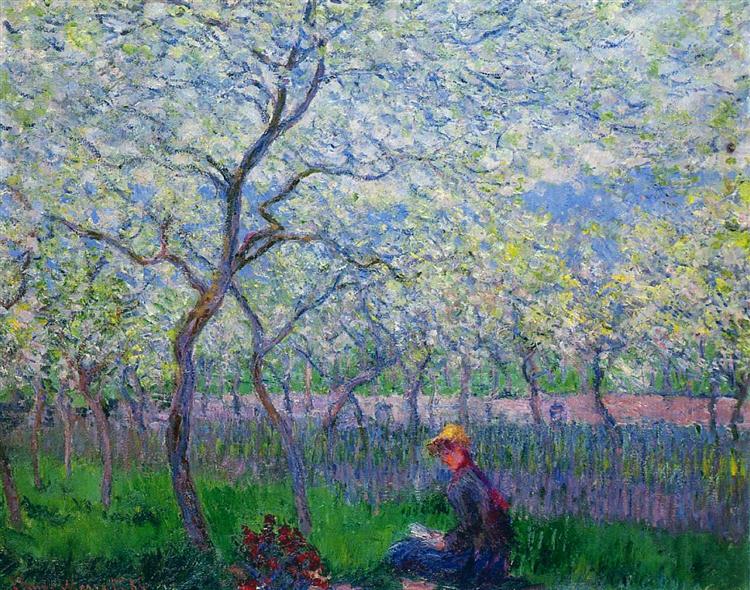
Inspiration and Theme
- The painting is inspired by the renewal and rebirth associated with spring.
- It explores growth, beauty, and the cyclical nature of life.
- The work captures the delicate beauty of blossoming fruit trees.
Visual Elements
- The artist likely uses a light, pastel color palette to depict spring blossoms.
- Attention to detail may be evident in rendering individual flowers and branches.
- The painting probably employs techniques to capture the play of light through the trees.
Artistic Impact
- “Orchard in Spring” contributes to the floral and seasonal art tradition.
- It likely evokes feelings of joy and renewal in viewers and may influence how other artists depict spring scenes.
“Orchard in Spring” invites viewers to experience the freshness of a new season.
It captures a moment of fragile yet vibrant natural beauty, celebrating nature’s ability to renew each year.
26. Old Town Alley
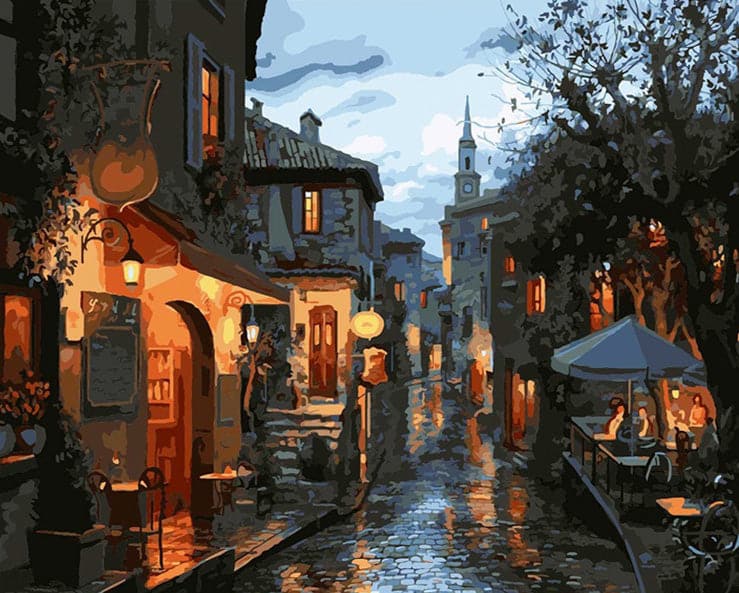
Inspiration and Theme
- The painting draws inspiration from the charm and history of urban architecture.
- It explores themes of nostalgia, the passage of time, and hidden urban beauty.
- The work likely captures the intimate details of a narrow, historic street.
Details and Technique
- The artist probably employs careful brushwork to depict architectural details.
- A muted color palette may be used to convey age and weathering.
- Techniques for rendering light and shadow likely play a key role in creating atmosphere.
Artistic Impact
- “Old Town Alley” contributes to the urban landscape painting genre.
- It may evoke feelings of nostalgia and curiosity in viewers.
- The painting could influence how other artists depict historic urban scenes.
“Old Town Alley” invites viewers into a slice of urban history.
It captures the quiet charm of spaces often overlooked in bustling cities.
The work reminds viewers of the stories and characters embedded in old architecture.
27. Olive Trees at Sunset
Inspiration and Theme
- The timeless beauty of Mediterranean landscapes inspires the painting.
- It explores themes of tranquility, ancient traditions, and the interplay of nature and light.
- The work captures olive trees’ unique silhouette and texture against a setting sun.
Light and Color
- The artist likely uses a warm color palette to depict the golden glow of sunset.
- Techniques for capturing the interplay of light and shadow through the trees are probably employed.
- The painting may contrast the silver-green olive leaves with the warm tones of the sky.
Artistic Impact
- “Olive Trees at Sunset” contributes to the tradition of Mediterranean landscape painting.
- It likely evokes a sense of peace and connection to nature in viewers and may influence how other artists depict iconic Mediterranean scenes.
“Olive Trees at Sunset” invites viewers to experience a moment of Mediterranean serenity.
It captures the timeless beauty of a landscape steeped in history and natural wonder.
The work is a tribute to the enduring appeal of sunlit olive groves in art.
28. Orion’s Belt

Inspiration and Theme
- The painting draws inspiration from the night sky and celestial bodies.
- It explores themes of cosmic wonder, human curiosity about the universe, and the beauty of astronomical phenomena.
- The work likely focuses on the distinctive three-star pattern of Orion’s Belt.
Astronomical Accuracy
- The artist probably pays careful attention to the accurate positioning of the stars in Orion’s constellation.
- The painting may include surrounding stars and nebulae to provide context.
- Techniques to depict the vastness of space and the sparkling quality of stars are likely employed.
Artistic Impact
- “Orion’s Belt” contributes to the tradition of astronomical art. It may inspire viewers to look at the night sky with renewed interest.
- The painting could serve an educational purpose, helping viewers identify constellations.
“Orion’s Belt” invites viewers to contemplate the wonders of the night sky.
It captures the awe-inspiring beauty of a familiar yet distant celestial landmark and reminds us of humanity’s enduring fascination with the stars and our place in the universe.
29. Opal Skies

Inspiration and Theme
- The painting draws inspiration from the ethereal beauty of twilight skies.
- It explores themes of transient beauty, the fleeting nature of light, and the subtle color variations in the atmosphere.
- The work likely captures the delicate, opalescent hues visible during twilight hours.
Color and Technique
- The artist probably uses a soft, pastel color palette to depict the subtle gradations of the twilight sky.
- Techniques for blending colors smoothly are likely employed to create a seamless transition of hues.
- The painting may feature delicate brushwork to capture the wispy nature of clouds and atmospheric effects.
Artistic Impact
- “Opal Skies” contributes to the atmospheric and sky painting tradition.
- It likely evokes a sense of calm and wonder in viewers, encouraging contemplation of natural beauty.
- The painting may influence how other artists approach depicting subtle atmospheric phenomena.
It invites viewers to pause and appreciate the quiet beauty of twilight.
It captures a fleeting moment of natural splendor that is often overlooked.
The work is a testament to the artist’s ability to render delicate atmospheric effects.
30. On the Riverbank
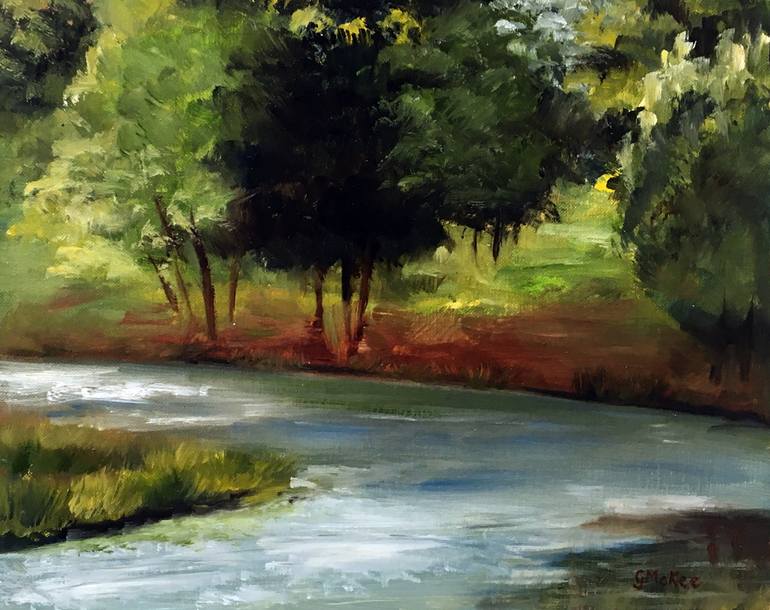
Inspiration and Theme
- The serene beauty of riverside landscapes inspires the painting.
- It explores themes of tranquility, the flow of nature, and the human connection to water.
- The work likely depicts a peaceful scene along a river, possibly including elements of flora and fauna.
Composition and Detail
- The artist probably employs a balanced composition that guides the eye along the riverbank.
- Attention to detail may be evident in depicting plants, rocks, and reflections on the water’s surface.
- Techniques for rendering the transparency and movement of water are likely used.
Artistic Impact
- On the Riverbank” contributes to the rich tradition of landscape painting.
- It likely evokes a sense of calm and connection with nature in viewers.
- The painting may influence how other artists depict waterside scenes and the interplay between land and water.
“On the Riverbank” Invites viewers to experience a moment of natural serenity.
It captures the gentle beauty of a riverside environment, encouraging reflection and relaxation.
The work reminds viewers of the restorative power of natural water bodies in art and life.
31. Over the Horizon

Inspiration and Theme
- The painting draws inspiration from the mystery and potential of the unseen.
- It explores themes of exploration, the unknown, and the human desire to look beyond current limits.
- The work likely depicts a vast landscape or seascape emphasizing the horizon line.
Perspective and Technique
- The artist probably uses perspective techniques to create a sense of vast distance.
- The painting may employ a gradation of colors or tones to suggest atmospheric depth.
- Brushwork might vary from detailed foreground elements to more abstract renderings of distant features.
Artistic Impact
- “Over the Horizon” contributes to the tradition of expansive landscape paintings.
- It likely evokes feelings of wonder and possibility in viewers, encouraging them to imagine what lies beyond.
- The painting may influence how other artists approach depicting concepts of distance and the unknown.
“Over the Horizon” invites viewers to contemplate what lies beyond their current view.
It captures the allure of the unknown and the human impulse to explore.
The work is a metaphor for possibility and the journey into uncharted territories.
32. Ode to Spring
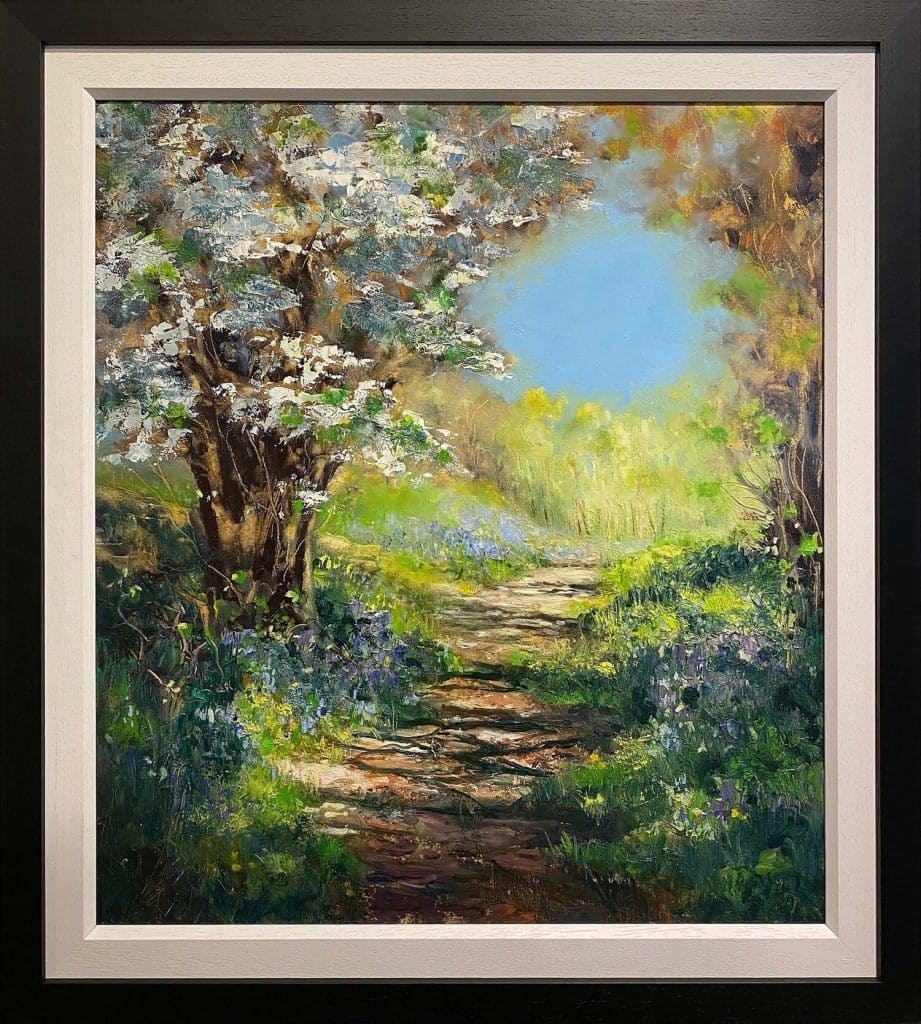
Inspiration and Theme
- Nature’s vibrant renewal inspires the painting in springtime.
- It explores themes of rebirth, growth, and the joyful energy of the season.
- The work likely depicts a lush, colorful scene full of blossoming plants and perhaps wildlife.
Visual Vibrancy
- The artist probably uses a bright, varied color palette to capture the diversity of spring hues.
- Techniques for depicting different textures of new growth, from delicate petals to fresh leaves, are likely employed.
- The painting may feature dynamic compositions to convey the energy of the season.
Artistic Impact
- “Ode to Spring” contributes to the long-standing tradition of seasonal paintings.
- It likely evokes feelings of joy and renewal in viewers, connecting them to the cyclical nature of life.
- The painting may influence how other artists approach depicting the vitality of spring.
“Ode to Spring” invites viewers to celebrate the return of life and color after winter.
It captures the exuberant energy and beauty of nature’s reawakening.
The work stands as a visual representation of hope and new beginnings.
33. Outskirts of the City

Inspiration and Theme
- The painting draws inspiration from the transitional spaces where urban meets rural.
- It explores themes of urban expansion, the contrast between natural and built environments, and the changing landscape of modern life.
- The work likely depicts a scene where city structures give way to more open, natural spaces.
Detail and Composition
- The artist probably employs a composition highlighting the contrast between urban and rural elements.
- Attention to detail may be evident in depicting buildings and natural features.
- Techniques for rendering different textures and atmospheric effects might be used to distinguish between the city and its outskirts.
Artistic Impact
- “Outskirts of the City” contributes to the genre of contemporary landscape painting.
- It likely prompts viewers to reflect on urban development and our relationship with nature, which may influence discussions about urban planning and preserving natural spaces.
“Outskirts of the City” invites viewers to consider the evolving relationship between urban and rural environments.
It captures a moment of transition, where the built world meets the natural world.
The work stands as a commentary on modern development and our changing landscapes.
34. Oceanic Dreams

Color and Technique
- The artist probably uses a range of blues and greens to create an underwater atmosphere.
- Techniques for depicting light filtering through water and the translucent quality of marine life are likely employed.
- The painting may feature fluid brushstrokes to convey the movement of water and sea creatures.
Artistic Impact
- “Oceanic Dreams” contributes to marine and fantasy art traditions.
- It likely evokes a sense of wonder and curiosity about the ocean’s depths in viewers.
- The painting may influence how other artists depict underwater scenes and marine ecosystems.
Oceanic Dreams Invites viewers to dive into an imaginary underwater world.
It captures the beauty and mystery of the ocean’s unexplored realms.
The work is a tribute to marine life’s rich biodiversity and allure.
35. Old Oak’s Whisper
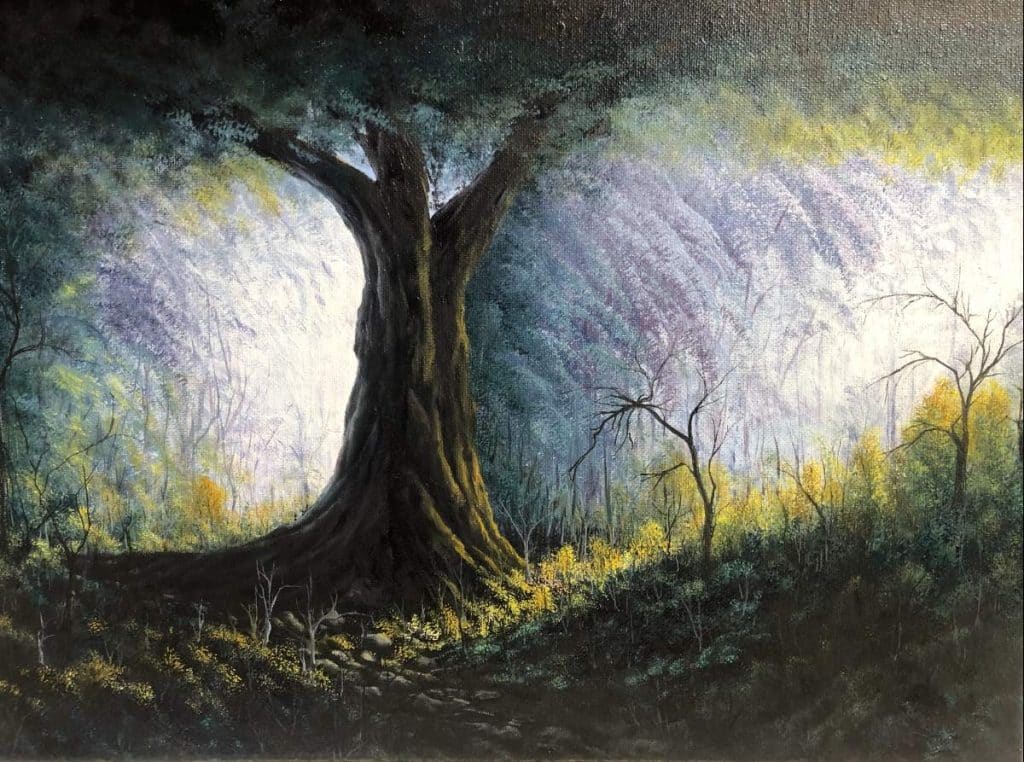
Inspiration and Theme
- The painting draws inspiration from ancient trees and their silent wisdom.
- It explores time, endurance, and the connection between nature and history.
- The work likely depicts a gnarled, old oak tree, possibly in a misty or atmospheric setting.
Detail and Technique
- The artist probably employs intricate brushwork to capture the texture of aged bark and twisted branches.
- Techniques for creating depth and atmosphere, such as layering and glazing, might be used.
- The painting may feature subtle lighting to enhance the tree’s sculptural qualities.
Artistic Impact
- “Old Oak’s Whisper” contributes to the tradition of tree portraiture in art.
- It likely evokes feelings of reverence for nature and the passage of time in viewers.
- The painting may influence how other artists depict ancient trees and their symbolic significance.
“Old Oak’s Whisper” invites viewers to contemplate the silent stories within old trees.
It captures the dignity and resilience of nature’s ancient sentinels.
It also reminds one of the deep connections between human history and the natural world.
36. “Opulent Orchids”

Inspiration and Theme
- The exotic beauty and diversity of orchids inspire the painting.
- It explores themes of elegance, rarity, and the intricate designs found in nature.
- The work likely depicts a variety of orchid species in vibrant detail.
Color and Composition
- The artist probably uses a rich, varied color palette to showcase the diverse hues of different orchids.
- Techniques for rendering the delicate textures of petals and the unique shapes of orchid blooms are likely employed.
- The composition may feature a dynamic arrangement highlighting the flowers’ graceful forms.
Artistic Impact
- “Opulent Orchids” contributes to botanical art and still-life painting tradition.
- It likely evokes viewers’ appreciation for the complexity and beauty of plant life.
- The painting may influence other artists’ depictions of exotic flowers and intricate natural forms.
“Opulent Orchids” invites viewers to marvel at the exquisite designs found in nature.
It captures the allure and diversity of one of the world’s most fascinating flower families and celebrates nature’s ability to create complex beauty.
Summming up
In conclusion, exploring the world of artists whose names begin with “O” reveals a rich tapestry of artistic expression.
These artists have left an indelible mark on art history, from Odilon Redon’s mystical symbolism to Olafur Eliasson’s immersive installations.
Their diverse works invite us to explore themes of nature, human emotion, and societal change.
Each painting we’ve examined offers a unique window into the artist’s vision and the world they inhabit.
As we reflect on these masterpieces, we’re reminded of art’s power to challenge, inspire, and connect us across time and culture.
Whether you’re drawn to Otto Mueller’s bold expressionism or Olga Boznanska’s portraits’ delicate beauty, there’s something here for every art enthusiast.
What’s your favorite work among these “O” artists?
Share your thoughts in the comments below!

